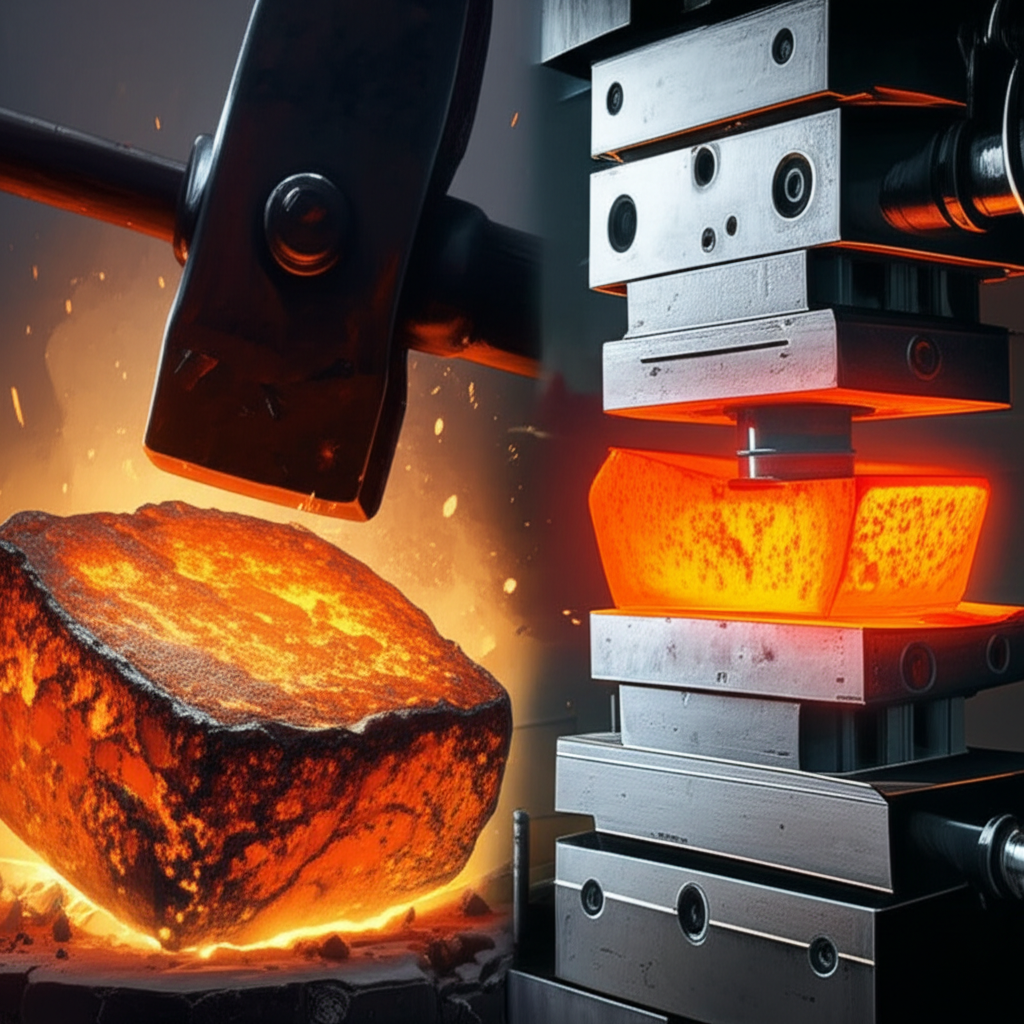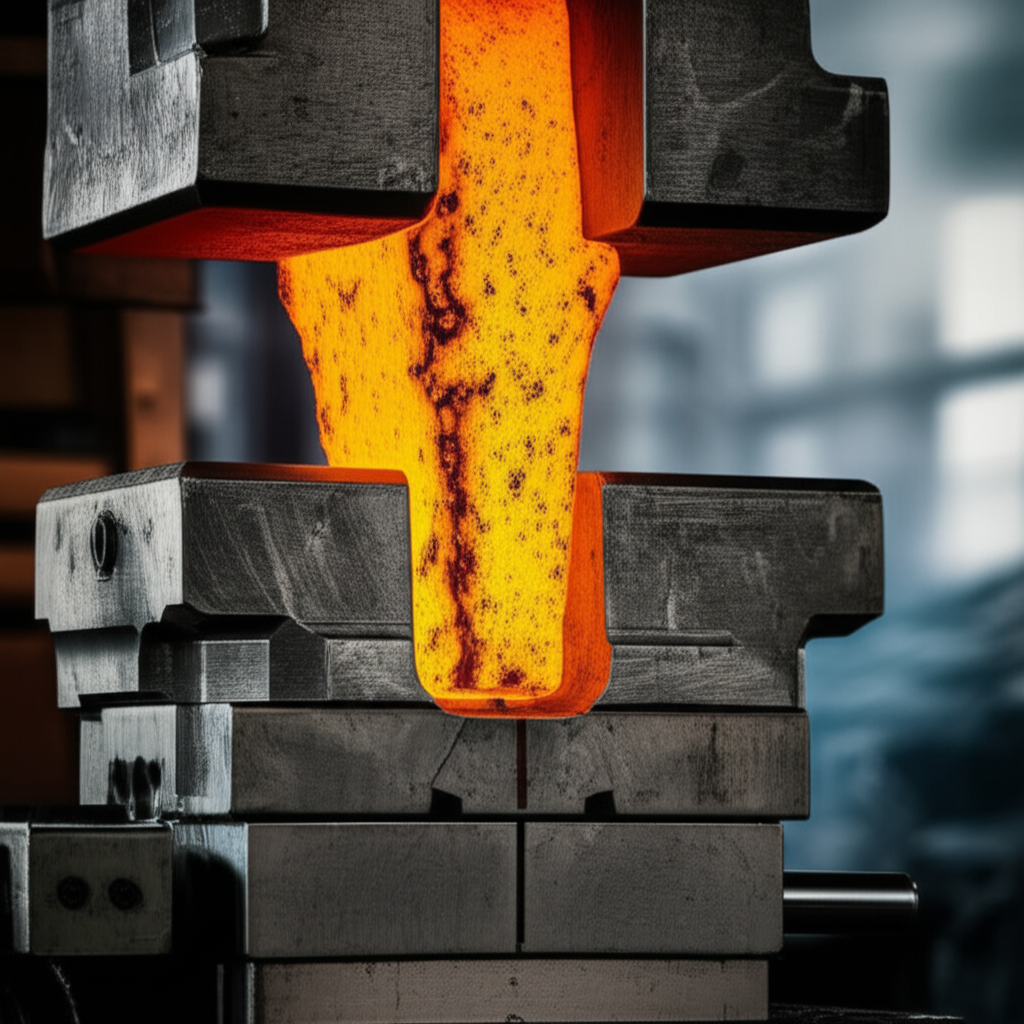Open-Die vs. Closed-Die Forging: Key Differences Explained

TL;DR
Open-die forging shapes heated metal between flat or simple dies that do not fully enclose it, making it ideal for large, simple components with lower tooling costs. In contrast, closed-die forging, or impression-die forging, uses enclosed, custom-shaped dies to produce complex, high-precision parts with superior surface finishes, which is more cost-effective for high-volume production runs.
Understanding Open-Die Forging: The Basics
Open-die forging, sometimes called free forging or smith forging, is a metalworking process where a workpiece is shaped between dies that do not completely enclose the material. Instead of being confined to a mold-like cavity, the metal is skillfully manipulated, often by a skilled operator, as it is struck or pressed by hammers or flat dies. This method allows the metal to flow outwards as it is compressed, requiring a series of movements to progressively achieve the final, often simple, geometry.
The process begins by heating a metal billet to an optimal temperature, typically between 1900°F and 2250°F, to make it malleable. The heated metal is then placed on a stationary anvil or lower die. A hammer or press then delivers controlled force, deforming the workpiece. Because the dies are simple—often just flat, V-shaped, or semi-round—this method is highly adaptable and does not require part-specific tooling. This results in significantly lower tooling costs and shorter lead times, making it an excellent choice for prototypes, custom parts, or low-volume orders as noted by sources like Canton Drop Forge.
A key advantage of open-die forging is its effect on the metal's internal structure. The process creates a continuous and refined grain flow that follows the contour of the part, enhancing its strength, toughness, and fatigue resistance. This makes open-die forged components exceptionally durable and reliable. The method is best suited for producing large parts, including shafts, cylinders, rings, discs, and blocks, which are common in heavy industrial applications like mining, power generation, and press repair.

Understanding Closed-Die Forging: The Impression Method
Closed-die forging, widely known as impression-die forging, operates on a different principle. In this process, the heated metal workpiece is placed between two custom dies that contain the precise negative impression of the desired final shape. When the dies close under immense pressure, the metal is forced to flow and fill every detail of the cavity, effectively acting as a high-pressure mold. This method almost completely encloses the workpiece, offering unparalleled control over the final geometry.
A distinctive feature of this process is the formation of "flash"—a thin ribbon of excess material that squeezes out between the die faces. While it may seem like waste, flash is a crucial part of the process. As it cools rapidly, it increases resistance to flow, which builds pressure within the die cavity and forces the remaining metal into intricate crevices and sharp corners of the impression. This ensures the complete filling of the die for a highly detailed part. The flash is trimmed off in a subsequent operation. According to Milwaukee Forge, proper die design and flash trimming are critical to the success of the operation.
The primary benefits of closed-die forging are precision and repeatability. It can produce complex, multi-dimensional parts with tight tolerances and an excellent surface finish, minimizing or even eliminating the need for secondary machining. This makes it highly cost-effective for large production runs where the initial high cost of creating the custom dies can be amortized over thousands of identical parts. It is the preferred method for manufacturing safety-critical components in industries like aerospace, automotive, and oil and gas, where consistent quality and superior mechanical properties are non-negotiable.
Open-Die vs. Closed-Die: A Head-to-Head Comparison
Choosing between open-die and closed-die forging requires a clear understanding of their fundamental trade-offs. While both methods produce strong, durable parts, they serve different manufacturing needs related to complexity, volume, cost, and precision. The following table and detailed explanations break down the key distinctions to help guide the selection process.
| Factor | Open-Die Forging | Closed-Die Forging |
|---|---|---|
| Die Design & Complexity | Uses simple, often flat or universal dies that do not enclose the part. | Requires custom, complex dies that contain the exact impression of the part. |
| Part Precision & Tolerances | Lower precision with looser tolerances; often requires secondary machining. | High precision with very tight tolerances and a smooth surface finish. |
| Tooling Costs & Lead Time | Low tooling costs and short lead times as custom dies are not needed. | High initial tooling costs and longer lead times for die manufacturing. |
| Production Volume Suitability | Ideal for low-volume production, prototypes, and one-off custom parts. | Cost-effective for high-volume, mass production runs. |
| Part Size & Shape | Best for large, relatively simple shapes like shafts, blocks, and rings. | Excellent for small-to-medium, complex, and intricate parts. |
| Material Waste | Minimal waste as the process is less reliant on trimming excess material. | Higher material use due to the formation and subsequent trimming of flash. |
Tooling Costs and Production Volume
The most significant economic difference lies in tooling. Open-die forging's use of simple, universal dies makes it highly economical for small batches or single parts. In contrast, closed-die forging requires a substantial upfront investment in designing and manufacturing custom dies, which is only justifiable for large production volumes where the per-part cost becomes very low.
Precision and Complexity
When precision is paramount, closed-die forging is the clear winner. The enclosed impression ensures that every part is produced with a high degree of consistency and tight dimensional tolerances. As detailed by Anchor Harvey, this is critical for complex components in industries like aerospace. Open-die forging is less precise and is better suited for parts where some variation is acceptable or where final dimensions will be achieved through subsequent machining.
Mechanical Properties and Grain Flow
Both processes improve the metal's mechanical properties over casting or machining. Open-die forging is renowned for creating a continuous grain structure that enhances strength and fatigue life, especially in large components. Closed-die forging also produces superior strength by aligning the grain flow with the part's contours, resulting in components that are stronger and more reliable than their machined counterparts.

Choosing the Right Forging Process for Your Application
Selecting the optimal forging process is a critical decision that directly impacts project cost, lead time, and final part performance. The choice hinges on a careful evaluation of your specific application's requirements. Key factors to consider include the complexity of the part, the required production quantity, budget constraints, and the necessary mechanical properties.
For projects defined by large dimensions and simple geometries, open-die forging is often the most logical and cost-effective solution. It provides enhanced structural integrity without the high tooling costs associated with custom dies. Conversely, for projects involving intricate shapes, tight tolerances, and high production volumes, closed-die forging delivers the precision and repeatability necessary for consistent quality.
Consider the following scenarios to guide your decision:
- Use Open-Die Forging for: Prototypes and short production runs, very large components (e.g., industrial shafts, large rings), parts with simple geometries, and when minimizing initial tooling cost is the top priority.
- Use Closed-Die Forging for: Mass production of identical parts, safety-critical components requiring high strength and reliability, complex shapes that are difficult to machine, and applications demanding a superior surface finish.
Frequently Asked Questions
1. What are the advantages of open die forging?
The primary advantages of open die forging include lower tooling costs, shorter lead times, and the ability to produce very large parts. The process also improves the metal's mechanical properties by creating a continuous grain flow, which enhances strength, ductility, and resistance to fatigue. This makes it ideal for custom or low-volume production of structurally sound components.
2. What are the benefits of closed die forging?
Closed die forging offers exceptional precision, tight tolerances, and the ability to create complex and intricate shapes. It produces parts with a superior surface finish, reducing the need for secondary machining. Because the process is highly repeatable, it is extremely cost-effective for high-volume production runs, delivering consistent quality and enhanced mechanical strength for every component.
 Small batches, high standards. Our rapid prototyping service makes validation faster and easier —
Small batches, high standards. Our rapid prototyping service makes validation faster and easier — 
